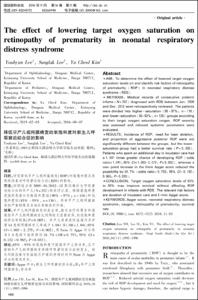The effect of lowering target oxygen saturation on retinopathy of prematurity in neonatal respiratory distress syndrome
- Keimyung Author(s)
- Kim, Yu Cheol; Lee, Sang Lak
- Journal Title
- International Eye Science
- Issued Date
- 2016
- Volume
- 16
- Issue
- 11
- Keyword
- Apgar score; neonatal respiratory distress syndrome; oxygen; retinopathy of prematurity; survival rate
- Abstract
- AIM: To determine the effect of lowered target oxygen
saturation levels on and identify risk factors of retinopathy
of prematurity ( ROP ) in neonatal respiratory distress
syndrome (RDS). METHODS: Medical records of consecutive preterm
infants (N = 252) diagnosed with RDS between Jan. 2009
and Dec. 2012 were retrospectively reviewed. The patients
were divided into higher - saturation (90 - 97% ; n = 116 ) and lower-saturation (85-93% ; n = 136) groups according
to their target oxygen saturation ranges. ROP severity
was assessed and relevant systemic parameters were
evaluated.
RESULTS: Incidence of ROP, need for laser ablation, and proportion of aggressive posterior ROP were not
significantly different between the groups, but the lowersaturation
group had a better survival rate (P = 0. 005).
Patients who spent an additional day in incubator care had
a 1. 041 times greater chance of developing ROP (odds
ratio = 1. 041; 95% CI = 1. 003-2. 275; P = 0. 002), whereas a
one- point increase in the 5min Apgar score reduced the
possibility by 24. 7% (odds ratio = 0. 753; 95% CI = 0. 152 -
0.965; P = 0. 033). CONCLUSION: Target oxygen saturation levels of 85%
to 93% may improve survival without affecting ROP
development in infants with RDS. The relevant risk factors
are duration of incubator care and 5-min Apgar score.
- Publisher
- School of Medicine
- Citation
- Youhyun Lee et al. (2016). The effect of lowering target oxygen saturation on retinopathy of prematurity in neonatal respiratory distress syndrome. International Eye Science, 16(11), 1992–1996. doi: 10. 3980/ j. issn. 1672-5123. 2016. 11. 03
- Type
- Article
- ISSN
- 1672-5123
- Appears in Collections:
- 1. School of Medicine (의과대학) > Dept. of Ophthalmology (안과학)
1. School of Medicine (의과대학) > Dept. of Pediatrics (소아청소년학)
- 파일 목록
-
-
Download
 oak-2017-0154.pdf
기타 데이터 / 381.53 kB / Adobe PDF
oak-2017-0154.pdf
기타 데이터 / 381.53 kB / Adobe PDF
-
Items in Repository are protected by copyright, with all rights reserved, unless otherwise indicated.